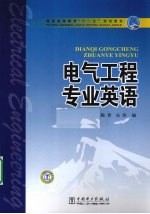

电气工程专业英语PDF电子书下载
- 电子书积分:11 积分如何计算积分?
- 作 者:陈青,丛伟编著
- 出 版 社:北京:中国电力出版社
- 出版年份:2010
- ISBN:9787512300682
- 页数:251 页
Unit 1 Basic Theory for Electrical Engineering 1
1.1 Electricity and Electromagnetic 1
1.1.1 What Electricity Is 1
1.1.2 Faraday's Law of Electromagnetic Induction 2
1.1.3 Magnetic Field 3
1.2 Engineering Circuit Analysis 6
1.2.1 Inductance and Capacitance 6
1.2.2 Circuit Analysis 7
1.3 Electronics and Automation 10
1.3.1 Logic Devices 10
1.3.2 Digital Circuits 13
1.3.3 Digital Signal Processing 16
1.4 Microcomputer 19
1.4.1 Single-Chip Microcomputer 19
1.4.2 Microprocessor 20
1.4.3 Microprocessor Applications 22
1.4.4 Computer System Software 24
Unit 2 Electrical Machines 28
2.1 Alternating-Current Machines 28
2.1.1 General 28
2.1.2 Synchronous Generator Principle and Construction Features 29
2.1.3 Synchronous Generator Performance 31
2.1.4 Synchronous Motors 33
2.2 Synchronous Machine Theory and Modeling 35
2.2.1 Physical Description 35
2.2.2 Mathematical Description of a Synchronous Machine 39
2.2.3 Basic Equations of a Synchronous Machine 43
2.2.4 The dq0 Transformation 48
2.3 Induction Motor 52
2.3.1 A General Outline of Induction Machines 52
2.3.2 Induction Motor Action 54
2.3.3 Construction Features of an Induction Motor 55
2.3.4 Running Conditions of an Induction Motor 58
2.4 Transformer 59
2.4.1 Single-phase Transformer Model 59
2.4.2 Equivalent Circuits for Practical Transformers 63
2.4.3 Three-Phase Transformer Connections 67
2.4.4 Per Unit Normalization 70
Unit 3 Power Electronics 74
3.1 Understanding FACTS:Basic Concept and General System Consideration 74
3.1.1 Opportunities for FACTS 74
3.1.2 Basic Types of FACTS Controllers 77
3.1.3 Description and Definitions of FACTS Controllers-shunt Connected Controllers 80
3.1.4 Basic Description and Definitions of FACTS Controllers-series Connected Controllers and Combined Controllers 85
3.1.5 Possible Benefits from FACTS Technology 88
3.2 Power Semiconductor Devices 93
3.2.1 Perspective on Power Devices 93
3.2.2 Integrated Gate-Commutated Thyristor and Insulated Gate Bipolar Thyristor 98
3.3 Static Compensators and Combined Compensators 101
3.3.1 Static Shunt Compensators:SVC and STATCOM 101
3.3.2 Static Series Compensators:Thyristor-Controlled Series Capacitor(TCSC) 103
3.3.3 The Unified Power Flow Controller(UPFC) 108
3.4 High Voltage Direct Current(HVDC)Transmission Systems Technology Review Paper 111
3.4.1 Introduction to HVDC 111
3.4.2 Advances in Technology and the Roles of HVDC 115
3.4.3 Design,Operation,Maintenance and Cost Considerations 119
3.4.4 HVDC Applications 124
Unit 4 Electric Power System 128
4.1 Introduction 128
4.1.1 Evolution of Electric Power Systems 128
4.1.2 Present and Future Trends of Power Systems 130
4.1.3 Structure of the Power System 132
4.1.4 Power System Control 134
4.1.5 Introduction to EHV AC Transmission 138
4.2 Electric Power Generation 140
4.2.1 Introduction 140
4.2.2 Power Station 141
4.2.3 Automatic Generation Control 144
4.2.4 Engineer's Role in Power Generation 147
4.3 Electric Power System Operation 151
4.3.1 Power System Planning 151
4.3.2 Power System Load 153
4.3.3 Reactive Power 155
4.3.4 Power System Monitoring 156
4.3.5 Economic Dispatching 158
4.4 Power System Stability Problem 161
4.4.1 Basic Concepts and Definitions 161
4.4.2 Rotor Angle Stability 162
4.4.3 The Stability Phenomena 164
4.4.4 Mid-Term and Long-Term Stability 165
4.4.5 Origin of Overvoltages and Their Types 166
4.5 Fault and Relaying Protection 168
4.5.1 Faults in Power System 168
4.5.2 Role of Protection in a Power System 169
4.5.3 Some Components of Protection 171
4.5.4 Fundamental Protection Principles 174
Unit 5 Distributed Power Generation 176
5.1 Distributed Generation Versus Traditional Power Systems 176
5.1.1 Distributed Versus Central Station Generation 176
5.1.2 Other Advantages and Disadvantages of DG 178
5.1.3 Power"from the Grid"as a Target for DG 179
5.2 Renewable Resource Distributed Generators 181
5.2.1 Introduction 181
5.2.2 Solar Thermal Power Generation 182
5.2.3 Photovoltaic(PV)Generation 184
5.2.4 Wind-Powered Generation 186
5.2.5 Other Renewable Generation Resources 189
5.3 Energy Storage for Use with Distributed Generation 192
5.3.1 Chemical,Electrical,or Physical Storage Systems for Electrical Energy 192
5.3.2 Battery Storage 193
5.3.3 Superconducting Magnetic Energy Storage(SMES) 195
5.3.4 Capacitor Storage 197
5.3.5 Mechanical Storage:Flywheels 200
5.4 Basic DG Case:Grid Interconnection Options 202
5.4.1 Potential Advantages of Interconnection 202
5.4.2 Potential Disadvantages of Interconnection 204
5.4.3 What Type of DG-Grid Interconnection? 206
5.4.4 Advantages and Disadvantages of DG-Grid Interconnection 207
Unit 6 专业英语的阅读、翻译与写作 210
6.1 专业英语的特点 210
6.2 专业英语中的特殊语法现象 212
6.3 专业英语中的常用句型 215
6.4 专业英语的翻译 222
6.4.1 被动语态的译法 222
6.4.2 倍数、分数和百分数的译法 223
6.4.3 定语从句的译法 223
6.4.4 名词性从句的译法 224
6.4.5 状语从句的译法 225
6.5 专业英语的写作 225
6.5.1 学术论文写作 225
6.5.2 简历 229
6.5.3 商务信函 230
6.5.4 产品技术说明书 232
词汇表 233
常用专业词汇 244
常用国外专业期刊名称 249
参考文献 251
- 《市政工程基础》杨岚编著 2009
- 《工程静力学》王科盛主编 2019
- 《中央财政支持提升专业服务产业发展能力项目水利工程专业课程建设成果 设施农业工程技术》赵英编 2018
- 《化学反应工程》许志美主编 2019
- 《绿色过程工程与清洁生产技术 张懿院士论文集精选 上》《绿色过程工程与清洁生产技术》编写组编 2019
- 《软件工程》齐治昌,谭庆平,宁洪编著 2019
- 《化学工程与工艺专业实验指导》郭跃萍主编 2019
- 《天水师范学院60周年校庆文库 新工科视域下的工程基础与应用研究》《天水师范学院60周年校庆文库》编委会编 2019
- 《高等工程教育改革探析》李瀛心,吴价宝著 1997
- 《城市基坑工程设计施工实践与应用》李欢秋,刘飞,郭进军编著 2019
- 《市政工程基础》杨岚编著 2009
- 《家畜百宝 猪、牛、羊、鸡的综合利用》山西省商业厅组织技术处编著 1959
- 《《道德经》200句》崇贤书院编著 2018
- 《高级英语阅读与听说教程》刘秀梅编著 2019
- 《计算机网络与通信基础》谢雨飞,田启川编著 2019
- 《看图自学吉他弹唱教程》陈飞编著 2019
- 《法语词汇认知联想记忆法》刘莲编著 2020
- 《培智学校义务教育实验教科书教师教学用书 生活适应 二年级 上》人民教育出版社,课程教材研究所,特殊教育课程教材研究中心编著 2019
- 《国家社科基金项目申报规范 技巧与案例 第3版 2020》文传浩,夏宇编著 2019
- 《流体力学》张扬军,彭杰,诸葛伟林编著 2019
- 《中国当代乡土小说文库 本乡本土》(中国)刘玉堂 2019
- 《异质性条件下技术创新最优市场结构研究 以中国高技术产业为例》千慧雄 2019
- 《中国铁路人 第三届现实主义网络文学征文大赛一等奖》恒传录著 2019
- 《莼江曲谱 2 中国昆曲博物馆藏稀见昆剧手抄曲谱汇编之一》郭腊梅主编;孙伊婷副主编;孙文明,孙伊婷编委;中国昆曲博物馆编 2018
- 《中国制造业绿色供应链发展研究报告》中国电子信息产业发展研究院 2019
- 《中国陈设艺术史》赵囡囡著 2019
- 《指向核心素养 北京十一学校名师教学设计 英语 七年级 上 配人教版》周志英总主编 2019
- 《《走近科学》精选丛书 中国UFO悬案调查》郭之文 2019
- 《清至民国中国西北戏剧经典唱段汇辑 第8卷》孔令纪 2018
- 《北京生态环境保护》《北京环境保护丛书》编委会编著 2018
